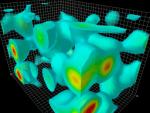Media Release |
 |
Adelaide physics link to Nobel Prize lecture |
Original version [0] |
| Friday, 17 December 2004 | |
Animations created at the University of Adelaide have been on display to the world, as featured by a Nobel Prize winner for Physics in his recent Nobel Prize Lecture in Stockholm, Sweden. The animations, created by Associate Professor in Physics at the University of Adelaide Dr Derek Leinweber, illustrate Quantum Chromodynamics (QCD), the underlying theory of the so-called “strong interactions” in quantum physics. These are the interactions between quarks and gluons, which are the building blocks of matter and energy in the universe. In his lecture on December 8, Nobel Laureate Professor Frank Wilczek used the animations, which were created by Dr Leinweber at the ARC Special Research Centre for the Subatomic Structure of Matter (CSSM) [1], based at the University of Adelaide. This year, there were three joint winners of the Nobel Prize in Physics: David J. Gross (University of California), H. David Politzer (California Institute of Technology) and Frank Wilczek (Massachusetts Institute of Technology). They’ve been recognised for their discovery of a particular behaviour of quarks, known as “asymptotic freedom”. Dr Leinweber says he was excited to learn that his visualisations would be featured in the Nobel Prize Lecture. "Of course I was delighted to be approached by Professor Wilczek to use our animations in his Nobel Prize Lecture. Many of these animations were designed precisely to bring the exciting world of QCD to the public in general," Dr Leinweber says. Supercomputing resources to study the complex interactions of quarks and gluons and create the CSSM Visualizations have been provided generously by the South Australian Partnership for Advanced Computing (SAPAC) [2] and the National Facility of the Australian Partnership for Advanced Computing (APAC) [3]. "We live in a unique time, when the predictions of quantum mechanics from the early 1900s, which led to the discovery of the transistor, are now realised as the seeds of modern technology where nearly every new electronic device contains a computer chip," says the Director of CSSM and SAPAC at the University of Adelaide, Professor Tony Williams. “"Today we use the fruits of quantum mechanics, namely supercomputers, to study the offspring of quantum mechanics; that of Quantum Field Theory." In his role as Deputy Director of Applications and Visualisations at SAPAC, Dr Leinweber aims to bring the capabilities of scientific data visualisation to South Australian researchers. "The SAPAC team is working hard to build a new Visualisation Suite to enable researchers and industry to understand complex data sets, and explore new research directions," Dr Leinweber says. The animations featured in Professor Wilczek's Nobel Prize Lecture may be viewed at: Professor Wilczek's lecture may be viewed in full at: | |
| Associate Professor Derek Leinweber (email) [4] Deputy Director, Special Research Centre for the Subatomic Structure of Matter (CSSM) The University of Adelaide Deputy Director (Applications & Visualisation), SA Partnership for Advanced Computing (SAPAC) Work: +61 8 8303 3423 Professor Tony Williams (email) [5] Director, SA Partnership for Advanced Computing (SAPAC) Director, Special Research Centre for the Subatomic Structure of Matter (CSSM) The University of Adelaide Work: +61 8 8303 3546 David Ellis (email) [6] Media Officer Marketing & Strategic Communications The University of Adelaide Work: +61 8 8303 3173 |
|
| [0] http://www.adelaide.edu.au/news/news3281.html [1] http://www.physics.adelaide.edu.au/cssm/ [2] http://www.sapac.edu.au/ [3] http://nf.apac.edu.au/ [4] mailto:dleinweb@physics.adelaide.edu.au [5] mailto:anthony.williams@adelaide.edu.au [6] mailto:david.ellis@adelaide.edu.au [7] http://www.adelaide.edu.au/news/image821/D.gif.html [8] http://www.physics.adelaide.edu.au/theory/staff/leinweber/index.html [9] http://www.adelaide.edu.au/news/image821/D.gif.html | |
|
Copyright © 2004 The University of Adelaide Last Modified Fri 17 Dec 2004 Online Media Unit [email] CRICOS Provider Number 00123M |
|
 [7]
[7]